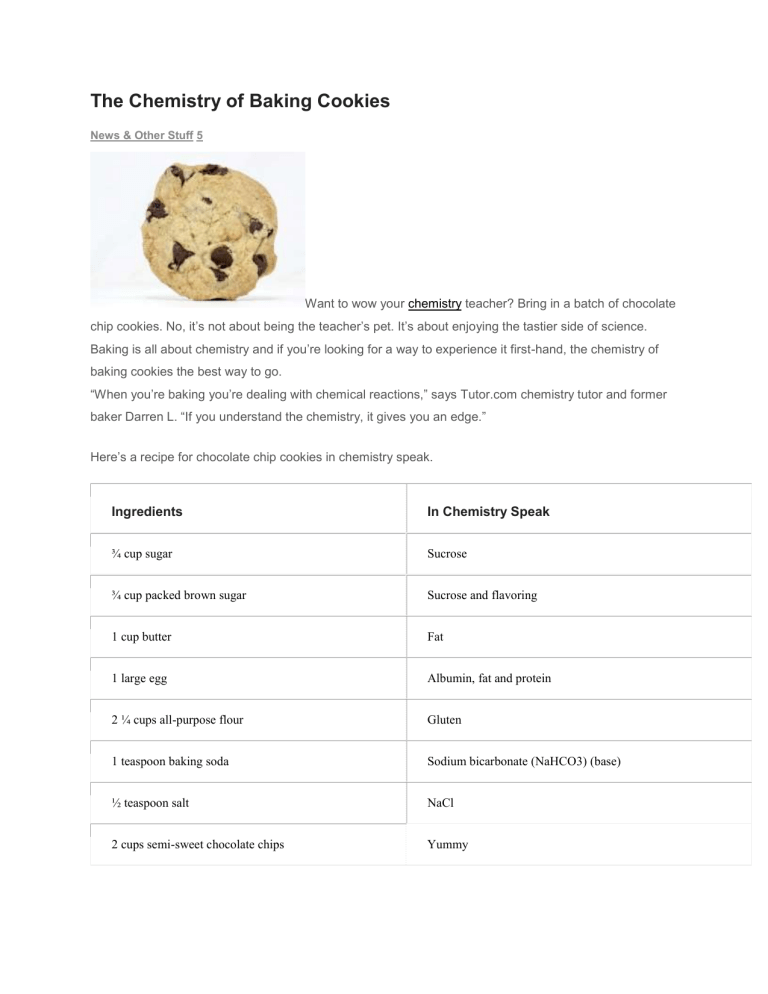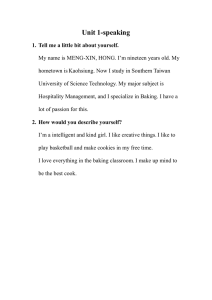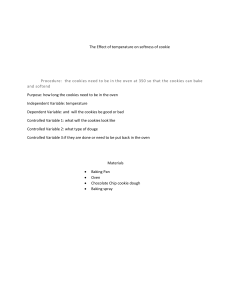
The Chemistry of Baking Cookies News & Other Stuff 5 Want to wow your chemistry teacher? Bring in a batch of chocolate chip cookies. No, it’s not about being the teacher’s pet. It’s about enjoying the tastier side of science. Baking is all about chemistry and if you’re looking for a way to experience it first-hand, the chemistry of baking cookies the best way to go. “When you’re baking you’re dealing with chemical reactions,” says Tutor.com chemistry tutor and former baker Darren L. “If you understand the chemistry, it gives you an edge.” Here’s a recipe for chocolate chip cookies in chemistry speak. Ingredients In Chemistry Speak ¾ cup sugar Sucrose ¾ cup packed brown sugar Sucrose and flavoring 1 cup butter Fat 1 large egg Albumin, fat and protein 2 ¼ cups all-purpose flour Gluten 1 teaspoon baking soda Sodium bicarbonate (NaHCO3) (base) ½ teaspoon salt NaCl 2 cups semi-sweet chocolate chips Yummy Directions The Chemistry of Baking Cookies Preheat oven to 375 degrees Mix sugar, brown sugar, butter and egg in a large bowl. Only physical changes. Stir in flour, baking soda, and salt. You add flour late in the process so that you won’t “work” the dough for too long, keeping the gluten complexes small. Stir in chocolate chips. Yummy! Drop dough by rounded tablespoonfuls 2 inches apart onto cookie sheet. Size matters. CO2 bubbles form throughout the entire cookie. Only the outside gets hot enough to caramelize. Bake 8 to 10 minutes or until light brown. The centers will be soft. When the batter heats up, the sucrose (sugar) breaks down into glucose and fructose, forming a polymer chain, giving the cookie its light brown, shiny crust. When sodium bicarbonate (baking soda) heats up, it causes a chemical reaction: 2NaHCO3 ? Na2CO3 + H2O + CO2. The CO2 gas that’s formed makes the “bubbles” in the cookies. NaCl (salt) keeps the bubbles from getting too big by slowing the production of CO2. The fat (butter) keeps the flour from forming an overly extensive network of gluten, giving the cookie a lighter texture. The fat and protein (egg yolk) hold the dough together and the albumin (egg whites) support the bubbles. Let cool for one minute then remove from cookie sheet and place on wire rack to finish cooling. Cooling allows caramelizing to be completed and allows structure developed by gluten and egg to set. http://blog.tutor.com/2010/01/the-chemistry-of-baking-cookies/


